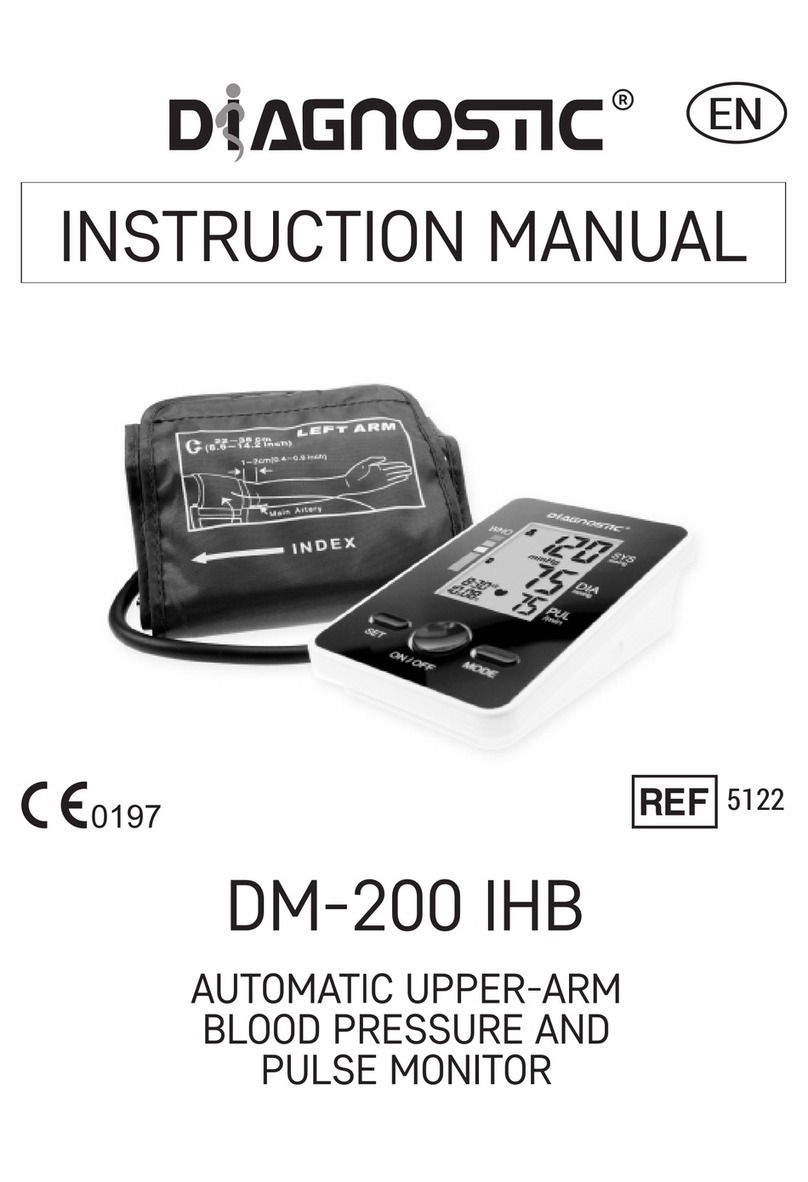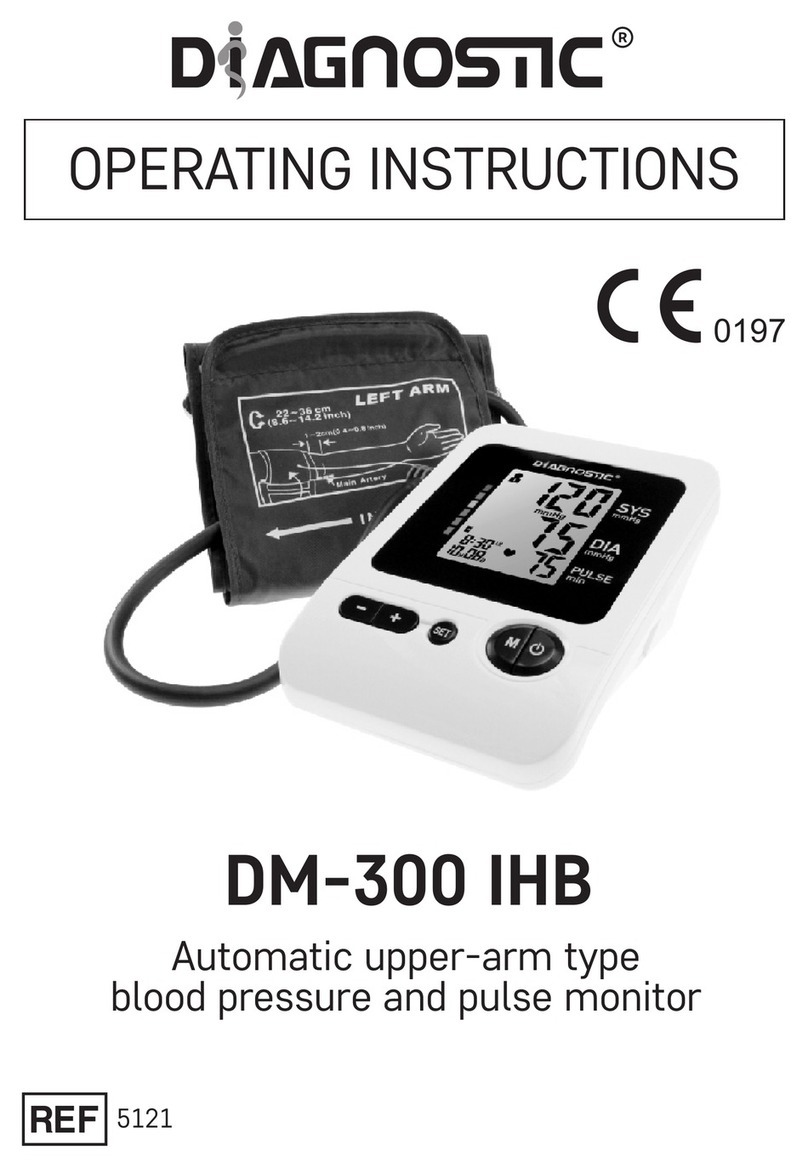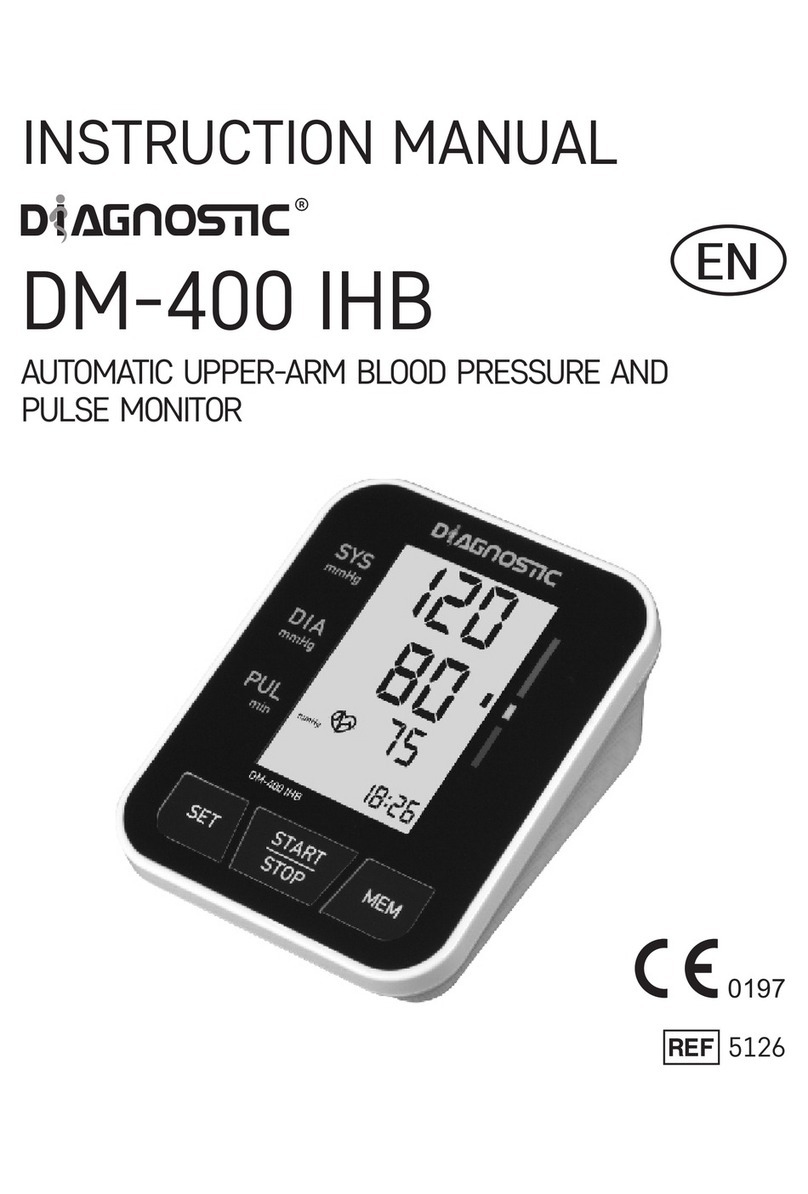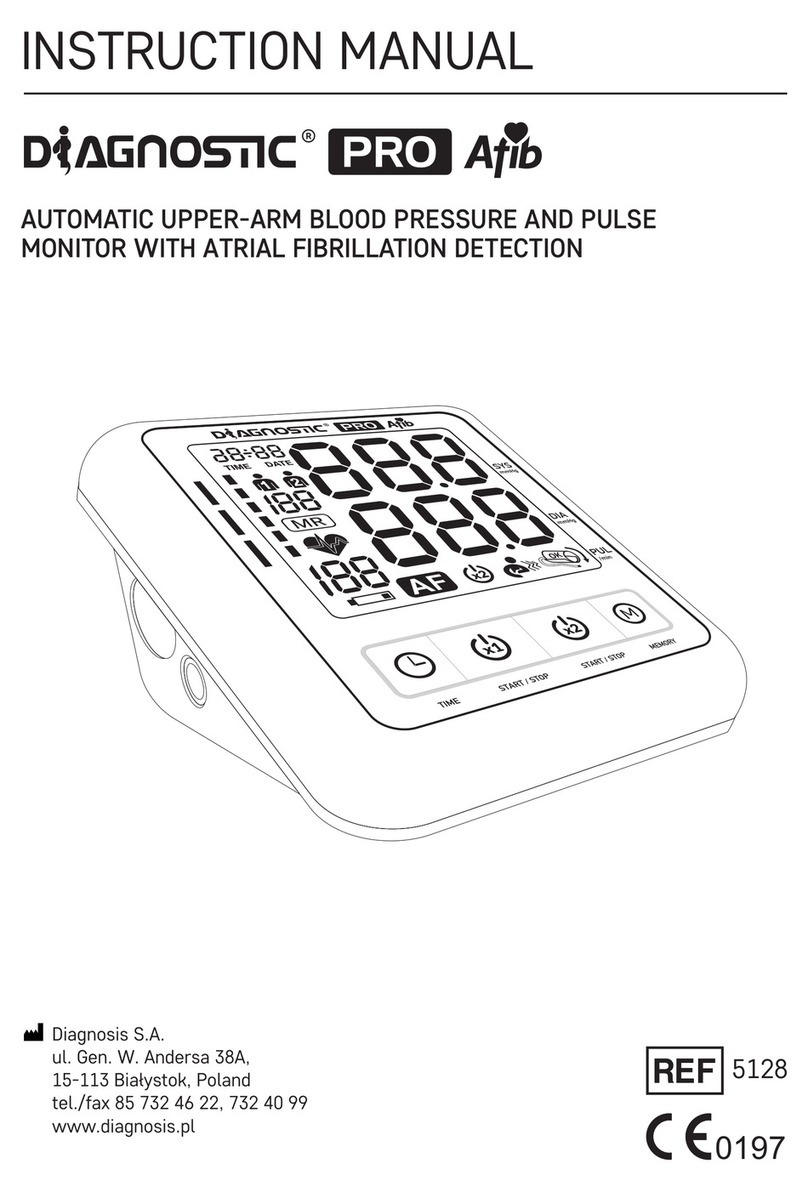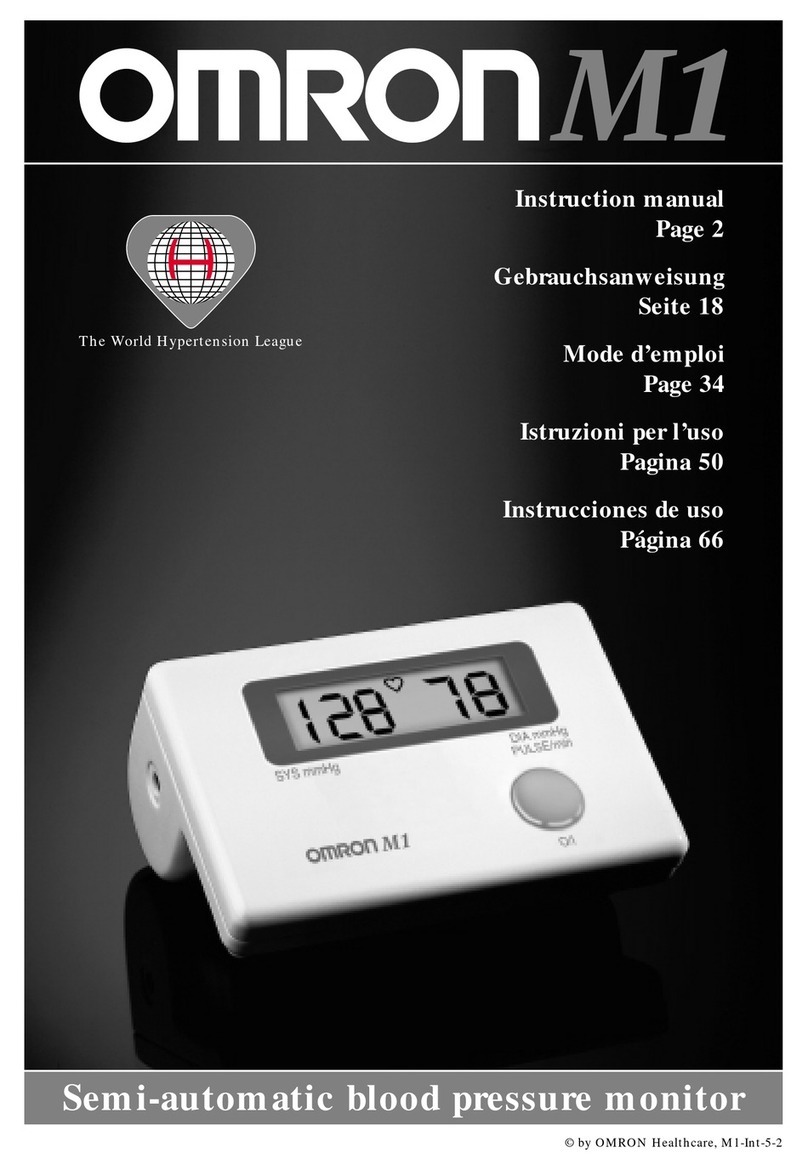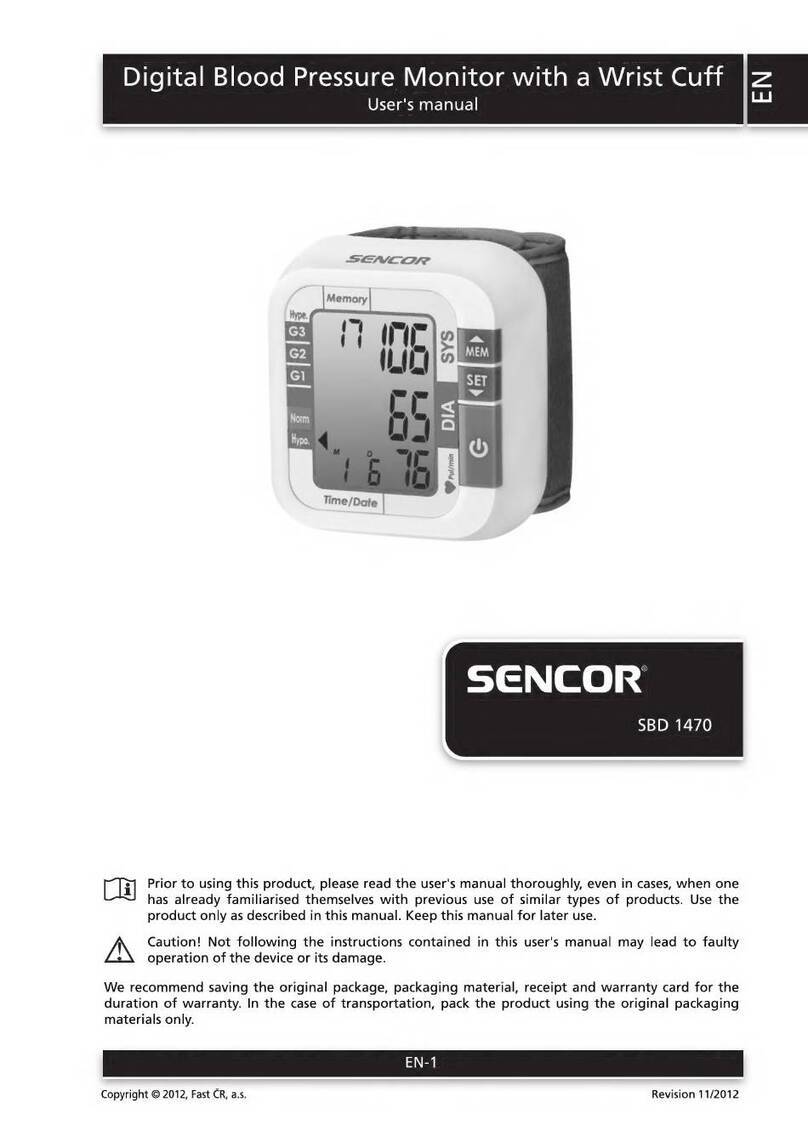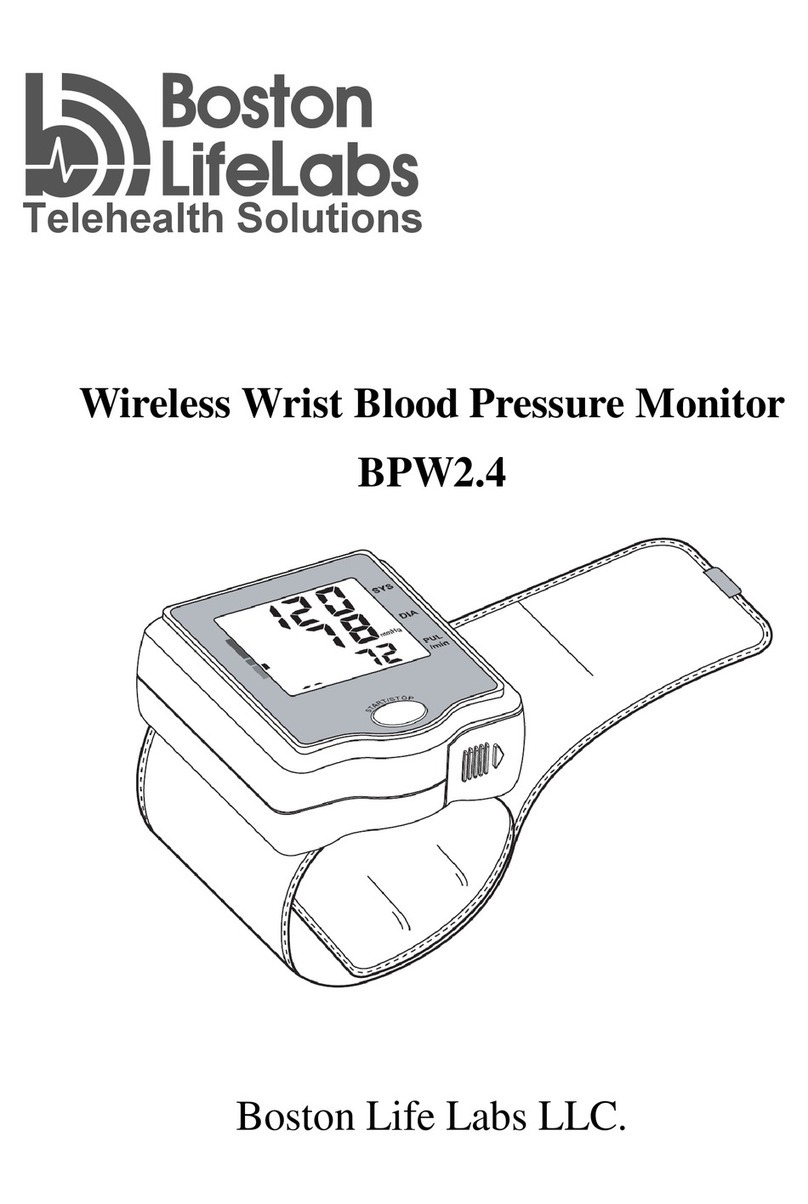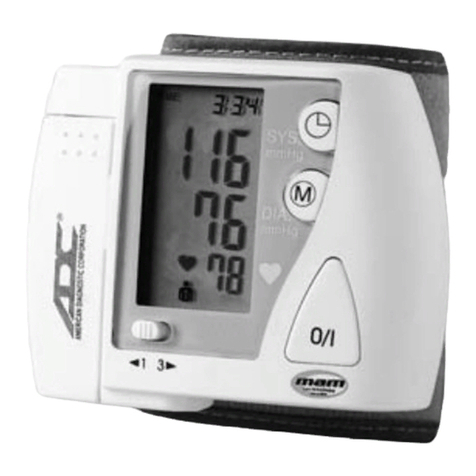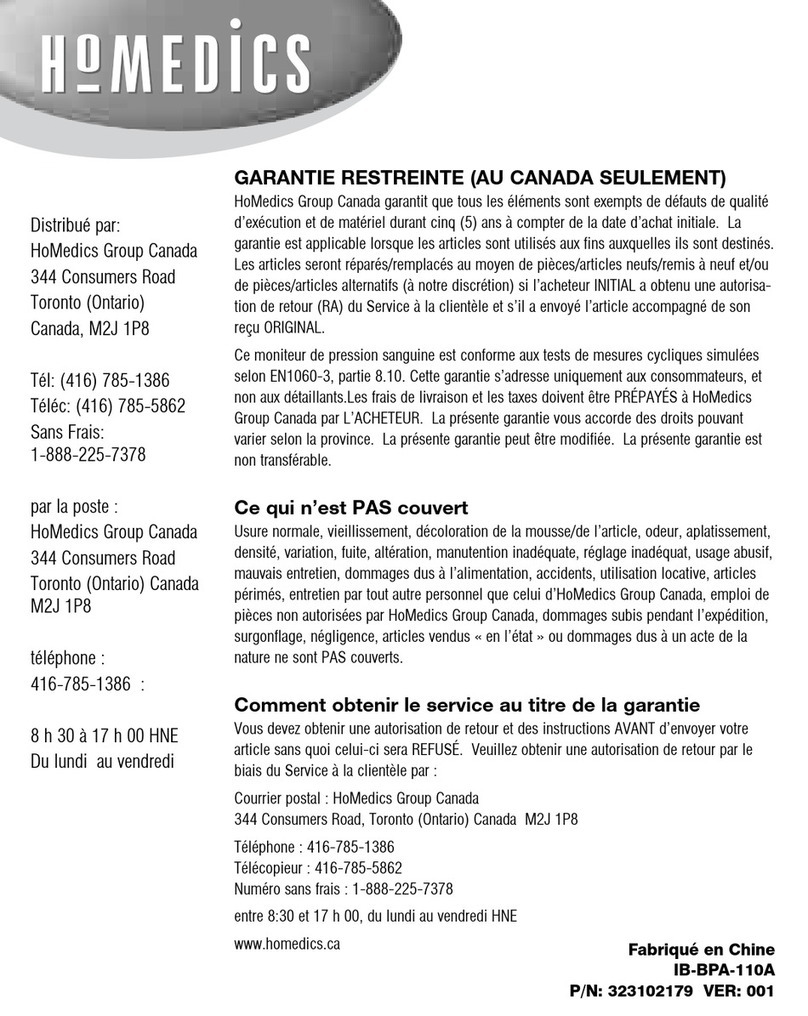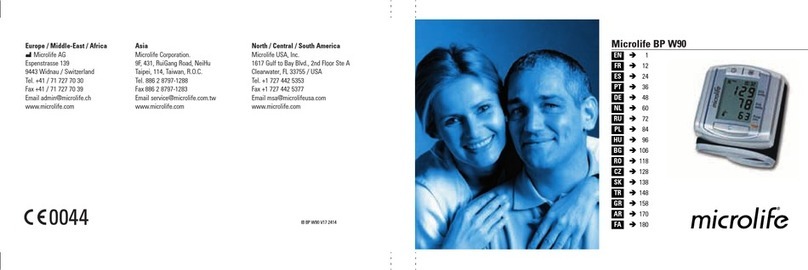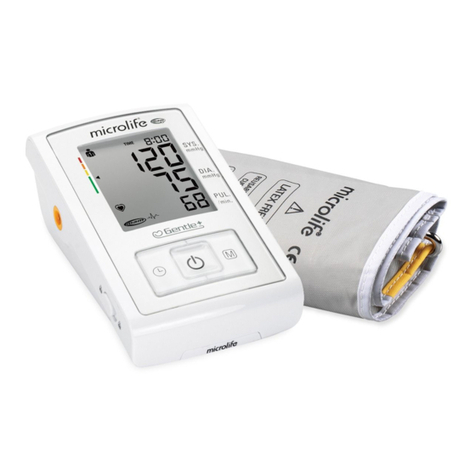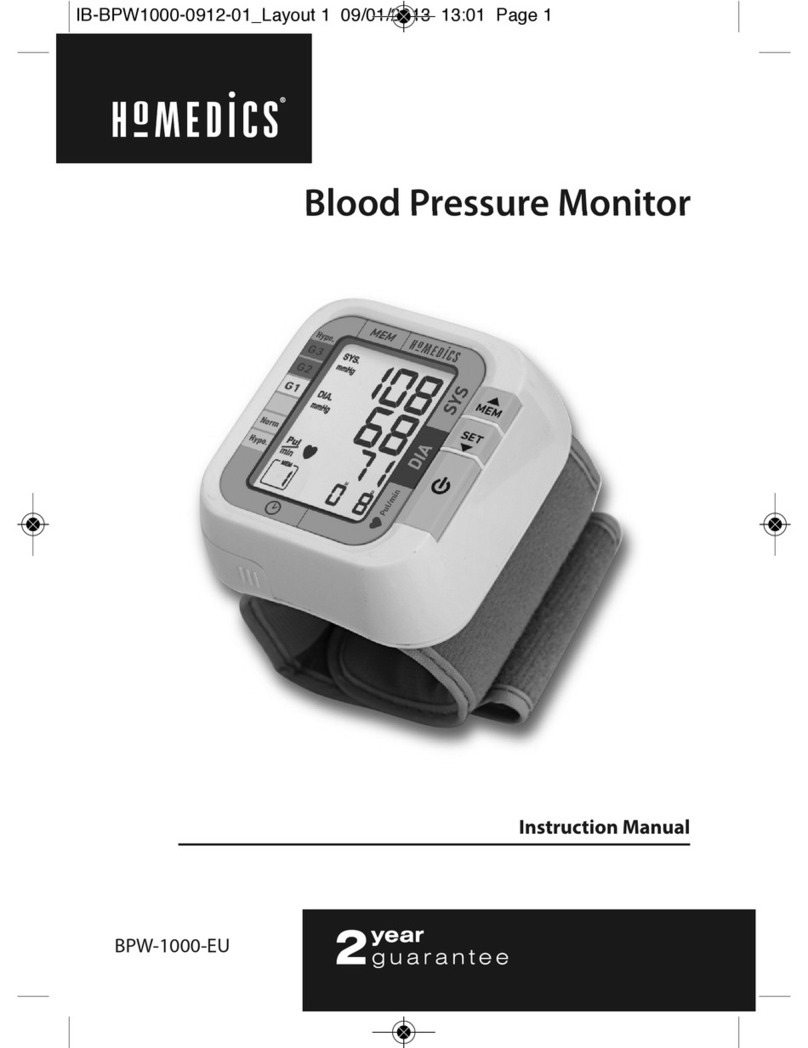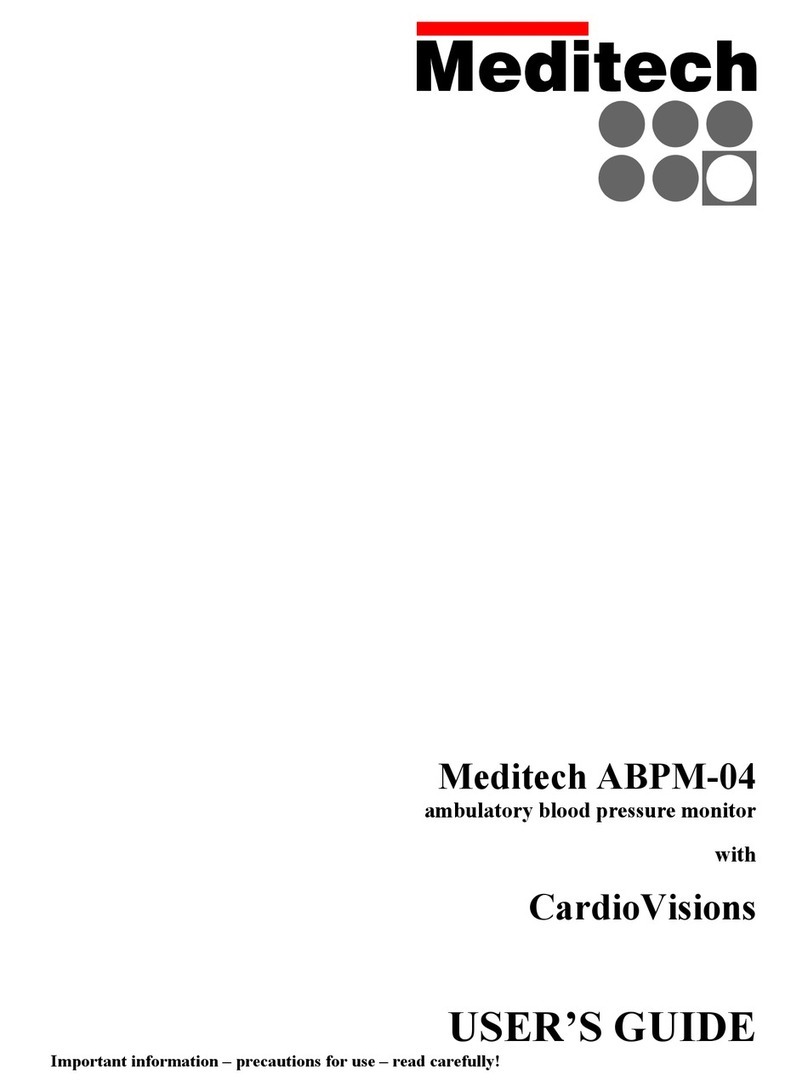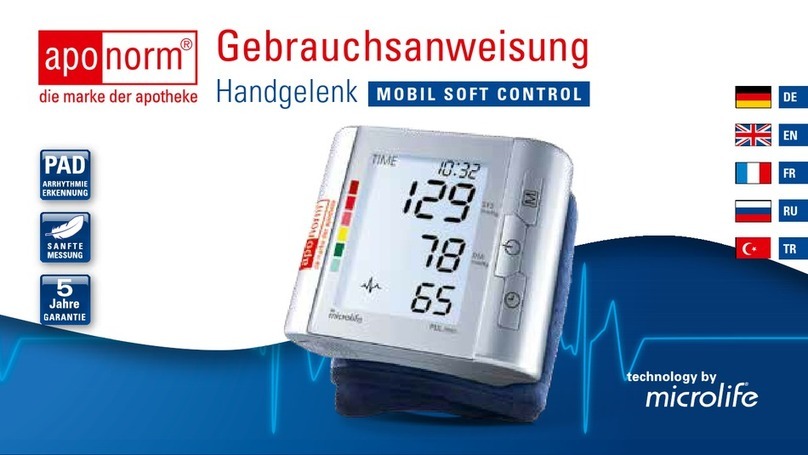Diagnostic DM-200 IHB Plus User manual

TABLE OF CONTENTS
1. INTRODUCTION . . . . . . . . . . . . . . . . . . . . . . . . . . . . . . . . . . . . . . . . . . . . . . . . . . . . . . . . . . . . . . . 1
1.1. Pressure gauge functions. . . . . . . . . . . . . . . . . . . . . . . . . . . . . . . . . . . . . . . . . . . . . . . . . . . . 1
1.2. Important information about self-measurement. . . . . . . . . . . . . . . . . . . . . . . . . . . . . . . . . 1
2. IMPORTANT INFORMATION ON BLOOD PRESSURE AND MEASUREMENT. . . . . . . . . . . . . . . . . . . . . . . . . . 2
2.1. How does undercutting / undercutting appear? . . . . . . . . . . . . . . . . . . . . . . . . . . . . . . . . 2
2.2. What is the correct pressure value? . . . . . . . . . . . . . . . . . . . . . . . . . . . . . . . . . . . . . . 2
3. CONSTRUCTION OF THE GAUGE. . . . . . . . . . . . . . . . . . . . . . . . . . . . . . . . . . . . . . . . . . . . . . . . . . . . 4
4. TUNING THE TURN GAUGE. . . . . . . . . . . . . . . . . . . . . . . . . . . . . . . . . . . . . . . . . . . . . . 5
4.1. Battery assembly. . . . . . . . . . . . . . . . . . . . . . . . . . . . . . . . . . . . . . . . . . . . . . . . . . . . . . . . . . . . . . 5
4.2. Battery life. . . . . . . . . . . . . . . . . . . . . . . . . . . . . . . . . . . . . . . . . . . . . . . . . . . 5
4.3. Power Supply . . . . . . . . . . . . . . . . . . . . . . . . . . . . . . . . . . . . . . . . . . . . . . . . . . . . . . . . . . . . . . . . . . . 5
4.4. User selection and date and time setting. . . . . . . . . . . . . . . . . . . . . . . . . . . . 6
5. PERFORMING MEASUREMENTS. . . . . . . . . . . . . . . . . . . . . . . . . . . . . . . . . . . . . . . . . . . . . . . . . . . . . 7
5.1. Before measuring. . . . . . . . . . . . . . . . . . . . . . . . . . . . . . . . . . . . . . . . . . . . . . . . . . . . . . . . . . . . 7
5.2. The most common errors. . . . . . . . . . . . . . . . . . . . . . . . . . . . . . . . . . . . . . . . . . . . . . 7
5.3. Attaching the cuff. . . . . . . . . . . . . . . . . . . . . . . . . . . . . . . . . . . . . . . . . . . . . . . . . . . . . . . 7
5.4. Body position during measurement. . . . . . . . . . . . . . . . . . . . . . . . . . . . . . . . . . . . . . . . . . . . . . 8
5.5. Measurement procedure. . . . . . . . . . . . . . . . . . . . . . . . . . . . . . . . . . . . . . . . . . . . . . . . . . . . . . . . . 8
5.6. End of measurement. . . . . . . . . . . . . . . . . . . . . . . . . . . . . . . . . . . . . . . . . . . . . . . . . . . . . . 8
6. MEMORY. . . . . . . . . . . . . . . . . . . . . . . . . . . . . . . . . . . . . . . . . . . . . . . . . . . . . . . . . . . . . . . . . . . . . . . . 9
6.1. Delete all measurements. . . . . . . . . . . . . . . . . . . . . . . . . . . . . . . . . . . . . . . . . . . . . 9
6.2. Early detection of irregular heartbeat. . . . . . . . . . . . . . . . . . . . . . . . . . . . . . 13
7. ERROR MESSAGES. . . . . . . . . . . . . . . . . . . . . . . . . . . . . . . . . . . . . . . . . . . . . . . . . . . . . 10
8. TROUBLE SHOOTING. . . . . . . . . . . . . . . . . . . . . . . . . . . . . . . . . . . . . . . . . . . . . . . . 10
9. MAINTENANCE AND CALIBRATION. . . . . . . . . . . . . . . . . . . . . . . . . . . . . . . . . . . . . . . . . . . . . . . . . . . 11
10. SAFETY AND DISPOSAL. . . . . . . . . . . . . . . . . . . . . . . . . . . . . . . . . . . . . . . . . . . . . . . . 11
11. SYMBOLS. . . . . . . . . . . . . . . . . . . . . . . . . . . . . . . . . . . . . . . . . . . . . . . . . . . . . . . . . . . . . . . . . . . . 12
12. TECHNICAL DATA. . . . . . . . . . . . . . . . . . . . . . . . . . . . . . . . . . . . . . . . . . . . . . . . . . . . . . . . . . . . 13

Thank you for purchasing the Diagnostic DM-200 IHB Plus blood pressure and pulse measuring
device. This model can be used with an irregular pulse. If the device detects an irregular pulse,
the symbol will appear in the display. In this case, it is recommended to visit a doctor.
Please read these instructions for use carefully before using the device for the first time.
Please keep the instructions for use. The information contained therein may be needed in
the future.
Before using the device, please read this manual carefully.
1. INTRODUCTION
1.1. Intended use of the product
The Diagnostic DM-200 IHB Plus blood pressure monitor is a fully automatic digital arm
pressure measurement device that allows you to perform quick and reliable
measurements of systolic and diastolic pressure, as well as pulse using the oscillometric
method.
This device provides a very high accuracy of measurements and has been
designed in such a way that its operation is as user-friendly as possible.
The device is intended for independent home blood pressure measurements.
For more information about your blood pressure and blood pressure measurement, please
contact your doctor.
1.2. Important information about self-measurement
NS Using a cuff other than the one recommended may result in a measurement error.
Do not use the device to measure blood pressure in infants.
Do not use the device in pregnant patients with pre-eclampsia.
NS
NS
NS Care must be taken to entangle the tubing to avoid serious injury to the patient or
disturbance of blood pressure measurement.
NS Too frequent measurements may injure the patient due to the disturbance of
blood flow.
NS Placing the cuff over a wound may deteriorate its condition.
NS The use of a cuff on the arm that is being treated may result in
injury by temporarily obstructing blood flow when the pressure is
raised.
NS Do not put on or inflate the cuff on the side on which the mastectomy was
performed.
NS Cuff inflation may temporarily stop vital functions monitoring
equipment while used on the same arm.
NS Measurement of pressure with an automatic pressure measuring device does not cause
long-term impairment of the patient's blood circulation.
NS The device is not suitable for simultaneous operation with high frequency (HF)
electrosurgical equipment.
Diagnostic DM-200 IHB Plus | 1

Self-measurement means control, not diagnosis and treatment. Always consult
your doctor about unusual values. Under no circumstances should you change
the doses of drugs prescribed by your doctor.
NS The displayed heart rate is not suitable for controlling the heart rate of the
pacemaker!
NS In the event of an arrhythmia, the measurement made with the device should be
consulted with a physician.
NS There is a risk of strangulation for babies in the air tubing or power cord.
NS Keep it out of the reach of children. Small parts of the kit pose a choking
hazard if swallowed.
NS The device is not intended for use by infants and persons who are unable
to communicate.
Electromagnetic interference
The device contains sensitive electrical components, therefore strong electric or
electromagnetic fields in the vicinity of the device should be avoided (e.g. cell phones,
microwave ovens). Otherwise, the accuracy of the measurements may temporarily
deteriorate.
2. IMPORTANT INFORMATION ON BLOOD PRESSURE AND MEASUREMENT
2.1. How does undercutting / undercutting appear?
The blood pressure level is regulated in the brain, in the circulatory center and adapted to the
current conditions by means of a feedback loop involving the nervous system.
In order to regulate blood pressure, both the strength of the heart's contractions and the
diameter of the vessels (the degree of contraction of the smooth muscles of the vessel walls)
change frequently. The blood pressure level changes periodically within the heart's cycle:
during a systole it is the highest value (systolic blood pressure), and at the end of a diastole it
is the lowest value (diastolic pressure). Your blood pressure should be normal to prevent
disease development.
2.2. What is the correct pressure value?
The blood pressure value is too high if the diastolic pressure at rest is over 90
mmHg or if the systolic pressure is over 160 mmHg. In this case, consult a
doctor immediately. Long-term maintenance of blood pressure at this level is a
threat to health due to the progressive damage to blood vessels.
If your systolic pressure is between 140 and 160 mmHg or your diastolic pressure is
between 90 and 100 mmHg, consult your doctor. After that, regular self-checks will be
necessary.
In case of too low values, i.e. systolic pressure below 100 mmHg or diastolic pressure
below 60 mmHg, also consult your doctor. Even with blood pressure within normal
range, regular blood pressure self-checks are recommended. This enables any
changes in blood pressure to be detected at an early stage and reacted
appropriately. If a patient is undergoing treatment for hypotension / hypotension,
regular measurements should be taken at a certain time of the day and the results
recorded and reported to the physician.
Never use the obtained results to change the dosage of drugs prescribed by
your doctor yourself.
Diagnostic DM-200 IHB Plus | 2

Blood pressure classification table (unit: mmHg) according to the World
Health Organization (WHO):
Range Pressures
systolic
Pressures
diastolic
measures
countermeasures
Optimal blood pressure
Blood pressure normal
up to 120
from 120 to 130
from 130 to 140
to 80
from 80 to 85
from 85 to 90
Self control
Self control
Consult a doctorSlightly elevated
blood pressure
Too high
blood pressure
from 140 to 160 from 90 to 100 Be sure to contact your
doctor
Much elevated
blood pressure
from 160 to 180 from 100 to 110 Be sure to contact your
doctor
Dangerously high
blood pressure
Above 180 Above 110 Contact a doctor
immediately!
NS If your blood pressure values are normal when you are resting, but
elevated during times of stress, you may be suffering from a so-called
labile (latent) overpressure. If you suspect this is possible, see your
doctor.
NS Properly measured diastolic blood pressure above 120 mmHg requires
immediate treatment.
Diagnostic DM-200 IHB Plus | 3

3. CONSTRUCTION OF THE GAUGE
Nest
on the cond
air
Button
DATE / TIME
TIME Nest
connection
power supply
Display
LCD
Button
START / STOP
Memory button
MEMORY
Connecting piece
air line
with pressure gauge
(puts in the socket
on the air pipe)
CUFF
(BF type part used) Arm
circumference range: 22-42
cm
Air line
ELEMENTS
DISPLAY
Metal buckle
1. Date / time
2. Blood pressure classification index
according to the World Health
Organization (WHO)
3. Users / Groups
4. Number of the memorized measurement
5. Symbol for average measured value
6. Unit of measure
7. Battery discharge symbol
8. Irregular heartbeat detection
symbol displayed after
completion of the measurement / pulse
symbol during the measurement
9. Worth your heartbeat
10. Systolic pressures
11. Diastolic pressures
1
2
3
4
5
6
7
10
811
9
Diagnostic DM-200 IHB Plus | 4

4. TUNING THE TURN GAUGE
4.1. Battery assembly
1. Remove the battery cover.
2. Put 4 standard AAA alkaline batteries.
NS Same brand batteries should be used.
NS Make sure that all the batteries are inserted in the correct direction according to their
polarity.
3. Replace the battery cover.
4. If the screen shows the low battery icon,
20% power is left.
5. If the battery warning icon is displayed on the screen, the
batteries are exhausted and need to be replaced.
, that is, complete
, it means that
NS Do not mix old and new batteries.
After replacing the battery, set the time and date again.NS
NS When the battery warning icon is displayed, the device will not turn on
until the battery is replaced.
NS Use Long-Life AAA type batteries or 1.5V alkaline batteries. 1.2V rechargeable
batteries are not recommended.
NS If the pressure gauge will be left idle for an extended period of time, remove the
batteries from the instrument.
4.2. Battery life
NS Four new LR6 (AAA) batteries supplied with the device are sufficient for
approximately 700 measurements (1 measurement per day at room temperature
23 ° C). Battery life varies with the temperature at which they are used and may be
shorter at lower temperatures.
NS You can check the battery status in the lower left corner of the screen. If the low
battery symbol is displayed, replace them with new ones.
4.3. Power adapter (optional)
1. Connect the power plug to the power adapter socket.
2. Insert the power adapter into the socket.
NS Use the correct power adapter for your local power supply. Power adapter
specification: 100 ~ 240V, 50 / 60Hz; output: micro USB DC 5V, 1ANS
NS We recommend that you only use the manufacturer's Diagnostic ZUI 5-1
power supply.
Kocwka
micro USB
NS Do not use the AC adapter if the device or the
power cord is damaged. Turn off the power
immediately and unplug the power cord
NS Do not plug in or unplug the AC adapter from the
wall outlet with wet hands.
NS When operating the device, do not tangle the
cables, twists and breaks.
NS Disconnect the AC adapter plug before
cleaning.
Power Supply
USB
Cond
USB
NS The power supply is added to the set optionally
(additionally payable).
Diagnostic DM-200 IHB Plus | 5

4.4. User selection and date and time setting
User Choice: The pressure gauge allows you to track the blood pressure
readings of 2 users.
a) Before starting the measurement, make sure that the correct user is set
up. The device can track the results of a maximum of 2 users (User 1,
User 2).
b) Hold down the TIME button with the device turned OFF for at least 3
seconds. A flashing user icon will appear on the screen.
c) The user will be changed by pressing the memory button. Press the
button to confirm the selection of the user.
d) We recommend that the first person to perform the measurement is user 1.
SETTINGS OF THE DATE, TIME AND MEASUREMENT UNIT
The pressure gauge has an integrated clock and displays the date. As a result, not only the
blood pressure measurement result is saved, but also the exact date and time of the
measurement. With new batteries inserted, the clock will be set to 12:00 and the date will be
01-01. You must then set the correct time and date. To do this, follow the steps below.
1. Hold down the TIME button with the device turned OFF for at least 3
seconds. The user icon will start flashing. Then press the TIME button
again to display the set year (4 characters blink).
2. Enter the year by pressing the MEMORY button.
3. Press the TIME button again. The date will be displayed with the month sign flashing.
4. Set the month with the MEMORY button.
5. Press the TIME button again. The last two characters (days) will flash.
6. Set the day using the MEMORY button.
7. Press the TIME button again. The device will switch to time setting. The hour mark
will start flashing.
8. Set the hours with the MEMORY button.
9. Press the TIME button again. The last two characters (minutes) will flash.
10. Set the minutes with the MEMORY button.
11. Press the TIME button. The unit of measure will flash.
12. Press the MEMORY button to set the measurement unit (mmHg or kPa)
13. After completing the settings, press the TIME button. The setting is
confirmed and the clock starts working.
14. Now when you have finished making all your settings, press the TIME button
again. The date will appear briefly, then the time. The settings made are now
confirmed and the clock starts timing.
OTHER INFORMATION
The TIME button advances to the next setting with each time it is pressed. The
MEMORY button changes the value by 1 (when entering the date / time settings, it
causes a change of +1, while in the history of measurements, it causes the transition
to the older measurement). By holding the button for 3-4 seconds, switching takes
place much faster.
Diagnostic DM-200 IHB Plus | 6

5. PERFORMING MEASUREMENTS
5.1. Before measuring
NS Immediately before the measurement, avoid any effort, do not smoke or smoke, as all these
activities have an influence on the measurement result. Before taking the measurement, you
should relax while sitting on the chair in a quiet environment for about 10 minutes.
NS The measurements should always be made on the same arm (usually the left arm).
NS You should take measurements regularly, at the same time each day, as blood
pressure varies throughout the day.
5.2. The most common errors
To make blood pressure measurements comparable, the same measuring conditions are necessary! These
conditions always include a quiet environment.
NS Any effort by the patient to support the arm may result in an increase in blood
pressure. Choose a comfortable and relaxed position. During the measurement, it
does not flex any muscles in the arm on which the cuff is wrapped. Use a pillow as
a support if necessary.
NS The operation of the pressure gauge may be disturbed by extremes of
temperature, humidity and measurement at high altitudes above sea level.
NS Be careful not to pinch or twist the tubing.
If the cuff is not fastened, the measurement results will be incorrect.NS
NS With repeated measurements, blood builds up in the arm, leading to
incorrect results. For this reason, blood pressure is correctly measured
after a 5-minute break or by raising the arm to allow any accumulated
blood to drain (at least after 3 minutes).
5.3. Attaching the cuff
1. Place the end of the air tube firmly in the hole on the left
side of the pressure gauge (air tube socket).
2. Place the end of the cuff under the metal cuff buckle
with the Velcro facing outwards.
3. Take the tight-fitting clothing off the shoulder on which you measure. Do not
use the cuff over thick clothing.
4. Place the cuff about 2-3 cm above the elbow. For best results, place the cuff on
your bare arm at heart level. The cuff should be wrapped on the arm so that
the air tube points towards the hand.
5. Cutting the arm due to the sleeve of
the garment being rolled up may
prevent accurate reading.
6. The cuff should be easily wrapped around the
arm and the Velcro should close easily.
7. After wrapping the cuff, make sure that you
can fit your finger under the cuff.
8. If the cuff does not fit on the arm, the reading
accuracy may not be correct.
Hand pointing
towards the game
Air line
should be
in the middle of the arm.
Diagnostic DM-200 IHB Plus | 7
2-3 cm

NS Do not kink the cuff or the air tube.
NS To detach the cuff, remove the air hose plug from the
pressure gauge.
NS Measurement can only be started after the cuff has been correctly wrapped.
NS The cuff should be replaced if there is a leak or if the cuff is not working
properly.
NS To ensure accurate readings, only the manufacturer's cuff should be
used.
5.4. Body position during measurement
Relax and rest your elbows on the table with the palm
of your hand facing the game. The cuff and arm should
be level with your heart. Reading accuracy may be
impaired if the cuff is not wrapped correctly. If the arm
is too low, the reading will be too high. If the arm is too
high, the reading will be too low. You should sit on a
chair. The legs should not be crossed and the feet
should not be on the floor. Sit down with your back
straight. Sit down so that you have support for your
back and shoulder.
Shoulder should
located on
the same height
what a heart.
5.5. Measurement procedure
After the cuff is wrapped correctly, you can start measuring.
a) Press the START / STOP button, the display will show all items, the cuff will
start inflating. Increasing cuff pressure is displayed continuously on the
screen (Fig. 1).
b) Once the correct pressure is reached, it will begin to slowly decrease. When a pulse is
detected, the heart icon on the screen will flash (Fig. 2).
c) After the measurement is completed, the values for systolic pressure, diastolic pressure and
the pulse will be displayed (Fig. 3).
Example (Fig. 3): systolic pressure 126, diastolic pressure 85, heart rate 78
The measurement results will be displayed until the device is turned off. If no
button is pressed for 3 minutes, the device will automatically turn off to conserve
battery power.
Fig. 1 Fig. 2 Fig. 3
5.6. End of measurement
You can press the START / STOP button at any time to stop the blood pressure measurement (for
example, when the patient is unwell). The device will automatically lower the cuff pressure.
Diagnostic DM-200 IHB Plus | 8

6. MEMORY
The internal memory stores up to 120 measurement results for each user.
1) Memory browsing
NS To access the memory resources, press the MEMORY button. The device will
display the average result from the last 3 measurements.
After pressing the MEMORY button, the last measurement is displayed.
.
NS
NS
NS Pressing the MEMORY button again allows the user to view the
measurements from the newest to the oldest (Figures 4 and 5).
Fig 4 Fig 5
6.1. Memory - deleting all measurement results
Before you delete any results stored in memory, make sure
you do not need them in the future. It makes sense to keep a
written record so that more information can be provided
when visiting the doctor's office. To delete all saved results,
hold down the MEMORY button for at least 5 seconds. Release
the button when "CL" is displayed on the screen. To
permanently delete all memory, press the MEMORY button
while "CL" is flashing.
6.2. Early detection of irregular heartbeat
If this symbol is displayed after the measurement has been completed, it means that an
irregular heart rate was detected during the measurement. In this case, the result may differ
from your normal blood pressure - repeat the measurement. In most cases, this is nothing to
worry about, but if this symbol appears regularly (e.g. several times a week with your daily
measurements) we recommend that you inform your doctor.
Provide the physician with the following explanation
Information for the physician on the frequent occurrence of the Irregular heartbeat indicator.
The device is an oscillometric pressure gauge which also analyzes the heart rate during the
measurement. The device has been tested in clinical conditions. If the device detects an
irregular heartbeat, the irregular heartbeat symbol will be displayed when the measurement is
complete. If this symbol appears regularly (e.g. several times a week with daily
measurements), we recommend that you contact your doctor.
The device is not a substitute for a cardiac examination, but serves as an aid in
detecting irregular heartbeat at an early stage.
Diagnostic DM-200 IHB Plus | 9

7. ERROR MESSAGES
If an error occurs during the measurement, the measurement will be aborted and an error code will be displayed.
Error code
ERR 1
ERR 2
Possible cause
Heart rate not detected.
The disturbance influenced the measurement result. Cause: There
was arm movement during the measurement.
ERR 3
ERR 5
Inflating the cuff for too long. The cuff has not been wrapped correctly.
The measurement showed an unacceptable difference between the systolic
and diastolic pressure. Make another measurement carefully following the
instructions. If you still get the abnormal results, see your doctor.
ERR 8 Pressures greater than 280 mmHg
Further information: Even in healthy people, blood pressure varies, so it is important to
always take measurements under the same conditions (quiet environment). If, despite
following these rules, fluctuations exceed 15 mmHg and you experience irregular heart
rate several times, consult your doctor.
In case of problems, please consult Diagnosis SA
Never try to repair the device yourself! All unauthorized attempts
to open the device will void the warranty!
8. TROUBLESHOOTING
If a problem occurs while using the machine, check the following items and take
the countermeasures listed.
Fault countermeasures
The screen remains dark even though the
device is turned on and the batteries are
inserted.
1. Check that the batteries are correctly oriented (poles)
and, if necessary, correct them.
2. If the display is incorrect, reinstall the batteries or replace
them.
The device often cannot measure the
pressure or the measurement results are
too low (or too high).
1. Check the position of the cuff.
2. Measure the blood pressure again in a quiet and calm environment
according to the instructions for use.
The results of each measurement are different,
although the device is working properly and
the values are also displayed correctly.
1. Read the information below and the information in the "Frequently
Occurring Errors" section. Repeat the measurement.
Please remember: your blood pressure fluctuates constantly, so subsequent
measurements will have some variation.
The blood pressure measurement result
differs from what was measured by your
doctor.
1. Record the daily measurement results and consult them with your
doctor.Please remember: some people feel nervous when they see
their doctor, which may increase their blood pressure (relative to
the level of a home measurement).
Diagnostic DM-200 IHB Plus | 10

9. MAINTENANCE AND CALIBRATION
a) Do not expose the device to extreme temperatures, humidity, dust and
direct sunlight.
b) The cuff has a sensitive, airtight reservoir (bladder). Be careful when handling
it and avoid deforming it by twisting or bending.
c) Clean the device with a soft and dry cloth. Do not use gasoline, thinners or
similar solvents. Stains on the cuff should be removed carefully with a damp
cloth and soapsuds. Do not get wet or wash the cuff!
d) Take care not to drop the device and handle it with care. Protect the device
against strong vibrations and shocks.
e) Do not open the device. Otherwise, the calibration by the manufacturer will be
invalid!
PERIODIC CHECKS
NS The measuring device requires regular checks.
NS For this reason, we recommend that you carry out periodic pressure gauge checks every 2 years. For
more information, please contact Diagnosis SA
NS The product lifetime is defined as 5 years.
10. SAFETY AND DISPOSAL
NS This device may only be used for its intended purpose as described
in the instructions for use. The manufacturer is not responsible for
any damage caused by improper use of the device.
NS The device contains sensitive components and must be handled with care.
The conditions for storage and use (technical data) must be adhered to.
NS It protects the device from water and moisture, extreme temperatures,
impacts, dropping, dust, direct sunlight, heat and cold.
NS Pump cuff only when applied.
NS Do not use the device near electromagnetic fields generated by mobile
phones and radio installations.
NS Does not use the device if it is damaged.
NS If the device will not be used for a long time, remove the batteries.
NS Only original elements provided by the Manufacturer should be used. The
use of other items may reduce the security level.
The device should be kept away from children and pets. Some parts
of the device are small and can be easily swallowed.
Diagnostic DM-200 IHB Plus | 11

11. SYMBOLS
SYMBOL FUNCTION / MEANING
Marking of the battery poles Warnings
Constant current
Systolic blood pressure in mmHg
Diastolic blood pressure in mmHg SN Serial number
Pulse - the number of heartbeats per minute date of production
Irregular heartbeat symbol Manufacturer
Symbol of the detected heart rate during the measurement Rev. Date of the last update
Protects against moisture Class II insulation
IP Protection against the ingress of water and foreign bodies Application part type BF
Keeps away from sunlight Product catalog number
For indoor use only
Before use, read the instructions for use
Dispose of the used product and batteries to a waste collection point.
Contains ingredients hazardous to the environment. When disposed of
correctly, you conserve valuable resources and avoid any negative effects on
health and the environment which could be compromised by inappropriate
waste handling. If in doubt about where to return the used camera, contact
Diagnosis.
Diagnostic DM-200 IHB Plus | 12

12. TECHNICAL DATA
Measurement method
Display
Measurement range
Oscillometric
LCD digital screen
Pressures: 30 - 280 mmHg. Pulse:
40 - 199 beats per minute
Accuracy of measurement Pressures: ± 3 mmHg
Heart Rate: ± 5% of Reading
Inflating air into the cuff
Deflating the cuff
Memory function
Power
Automatic pumping device
Automatically by the air valve
2 x 120 measurement results with date and time
4 x 1.5 V AAA alkaline batteries or micro
USB adapter DC 5.0 V / 1.0 A (optional)
Terms of use Temperature: 5 - 40 ° C
Humidity: 15 - 85% RH
Atmospheric pressures: 860 - 1060 hPa
Transport and storage conditions Temperature: -10 - 55 ° C
Humidity: 10 - 95% RH
Atmospheric pressures: 860 - 1060 hPa
Dimensions
Libra
Cuff size
Protection against electric shock
135 × 90 × 41 ± 1.0 mm
372 g ± 5 g including batteries and cuff
Size M / L 22-42 cm
Internally Powered Medical Electrical Equipment (when
running on batteries only) Class II Medical Electrical
Equipment (optional power supply)
Safety classification
Operating mode
IP classification
Packaging included
Type BF device
Continuous work
IP22
Pressure gauge, cuff size M / L (22-42 cm), 4 x AAA
batteries, instructions for use, cover, power supply
(optional)
Diagnostic DM-200 IHB Plus | 13

Guidance and manufacturer's declaration - electromagnetic emissions
Diagnostic DM-200 IHB Plus is intended for use in the electromagnetic environment specified below. The
customer or the user of the device should make sure that the device is used in such an environment.
Emission test Fulfilling requires Electromagnetic Environment Guidelines
The emission of waves by o
frequency
radio; CISPR 11 standard
Group 1 Diagnostic DM-200 IHB Plus uses RF energy only for its
internal function. Consequently, these emissions are
very low and should not interfere with the operation of
nearby electronic equipment.
Radio frequency emission;
CISPR 11 standard
Class B Diagnostic DM-200 IHB Plus can be used in all buildings,
including domestic homes and buildings, that are directly
connected to the public low-voltage power supply network
that supplies buildings used for domestic purposes.
Harmonic emissions
IEC 61000-3-2
not applicable
Voltage fluctuations / flicker
emissions IEC 61000-3-3
RF- frequency from the section of the electromagnetic spectrum, which is between the lower range of long-
wave radio frequencies and the infrared range; a frequency usable for radio transmission. General limits are
9 kHz and 3,000 GHz
Guidelines and manufacturer's declaration regarding electromagnetic immunity
Diagnostic DM-200 IHB Plus is intended for use in the electromagnetic environment specified below. The
customer or the user of the Diagnostic DM-200 IHB Plus should assure that it will be used in such an
environment.
Immunity test Test level, norm
IEC 60601
Level
compliance
Electromagnetic environment
- tips
Discharge
electrostatic (ESD)
IEC 61000-4-2
± 6 kV contact
± 8 kV air
± 6 kV contact
± 8 kV air
Floors should be wooden, concrete or made of
ceramic tiles. If floors are covered with
synthetic material, the relative humidity should
be at least 30%. If ESD interferes with the
operation of the equipment, the use of
components should be considered
countermeasures ie wrist strap,
grounding.
Quick changers
temporary disturbances
IEC 61000-4-4
± 2 kV for power line. ±
1 kV for line
input / output
Not
refers to
The power quality should be the same as for
typical commercial or hospital installations.
Power surges
IEC 61000-4-5
± 1 kV differential mode. ±
2 kV common mode
Not
refers to
The power quality should be the same as for
typical commercial or hospital installations.
Voltage dips, short
interruptions and changes
voltage on the inputs
power line
IEC 61000-4-11
<5% UT (> 95% dip in
UT) for 0.5 cycles 40%
UT (60% dip in UT) for
5 cycles
70% UT (30% dip in
UT) for 25 cycles
<5% UT (> 95% dip de
UT) for 5 s
Not
refers to
The power quality should be the same as for typical
commercial or hospital installations. If the user [of
the device or the system] requires continuous use
of the device even during power cuts, we
recommend that you
connecting a device or system to an uninterruptible
power supply.
The magnetic field
power supply at a frequency
(50 / 60Hz) IEC 61000-4-8
3 A / m 3 A / m The level of the magnetic fields of the power
sources should be within the limits
valid for typical commercial or
hospital installations.
Note UT is the alternating voltage (AC) of the utility grid prior to application of the test level.
RF- frequency from the section of the electromagnetic spectrum, which is between the lower range of long-wave radio
frequencies and the infrared range; a frequency usable for radio transmission. General limits are 9 kHz and 3,000 GHz.
Diagnostic DM-200 IHB Plus | 14

Guidelines and manufacturer's declaration regarding electromagnetic immunity
Diagnostic DM-200 IHB Plus is intended for use in the electromagnetic environment specified below. The
customer or the user of the Diagnostic DM-200 IHB Plus should assure that it will be used in such an
environment.
Immunity test Test level,
standard IEC 60601
Level
compliance
Electromagnetic environment - tips
Conducted signal o
radio frequency
3 Vrms
150 kHz to 80 MHz
3 V Portable and mobile RF communications
equipment should be used at a distance not less
than the recommended distance from any
Diagnostic DM-200 IHB Plus components,
including cables, from the equation to the
frequency of the transmitter.
IEC 61000-4-6
The emitted signal o
radio frequency
3 V / m
80 MHz to 2.5 GHz
3 V / m
IEC 61000-4-3 Recommended distance
d = 1.2
d = 1.2
d = 2.3
80 MHz to 800 MHz
800 MHz to 2.5 GHz
where P is the maximum power rating of the transmitter in watts
(W) as stated by the manufacturer, and d is the recommended
separation distance in meters (m).
Field strengths from fixed RF transmitters,
as determined by an electromagnetic field
survey, should be less than the compliance
level in each frequency range.
Interference may occur in the vicinity of equipment
marked with the following symbol:
Recommended distance:
d = 1.2
Note 1: At 80 MHz and 800 MHz, the higher frequency range applies.
Note 2: The information provided is not applicable in all situations. The propagation of electromagnetic waves is influenced by
absorption and reflections from surfaces, objects and people.
(a) Field power from specific transmitters such as mobile phone base stations, radio transmitters, amateur
radio, AM and FM radio broadcast and TV broadcast cannot be predicted theoretically with accuracy. To assess
the electromagnetic environment, a site survey should be considered. If the measured field strength in the
location where the Diagnostic DM-200 IHB Plus is operating exceeds the appropriate compliance level, it
should be checked that the Diagnostic DM-200 IHB Plus is operating normally. If improper operation is
observed, it may be necessary to take appropriate preventive measures such as re-arranging or relocating the
Diagnostic DM-200 IHB Plus.
(b) For frequencies outside the range 150 kHz to 80 MHz, the field strength should not be greater than 3 V / m.
RF - frequency in the part of the electromagnetic spectrum, which is between the lower range of long-wave
radio frequencies and the infrared range; a frequency usable for radio transmission. General limits are 9
kHz and 3,000 GHz.
Diagnostic DM-200 IHB Plus | 15

Recommended separation distances between portable and mobile RF communications equipment and
Diagnostic DM-200 IHB Plus
Diagnostic DM-200 IHB Plus is intended for use in an electromagnetic environment in which radiated RF
disturbances are controlled. The customer or user of the Diagnostic DM-200 IHB Plus can help prevent
electromagnetic interference by maintaining a minimum separation distance between portable and
mobile RF communications equipment (transmitters) and the Diagnostic DM-200 IHB Plus as
recommended below, according to the maximum output power of the communications equipment.
Maximum power
nominal (W)
the transmitter
Distance in meters (m) according to the frequency of the transmitters
150 kHz to 80 MHz d
= 1.16
80 MHz to 800 MHz d
= 1.16
800 MHz to 2.5 GHz d
= 2.33
0.01 0.12 0.12 0.23
0.1 0.38 0.38 0.73
1 1.2 1.2 2.3
10 3.8 3.8 7.3
100 12 12 23
For transmitters rated at a maximum output power not listed below, the recommended separation distance d in
meters (m) may be estimated using an equation appropriate to the frequency of the transmitter, where P is the
maximum output power of the transmitter in watts as specified by the transmitter manufacturer.
NOTE 1 at 80 MHz and 800 MHz, the separation distance for the higher frequency range applies.
NOTE 2: These guidelines may not apply in all situations. The propagation of electromagnetic waves is
influenced by absorption and reflection from buildings, objects and people.
The product may only be used in the EU member states or in the country of
purchase. If you use it in other countries, you may violate the laws and
regulations of that country regarding radio communications.
Diagnostic DM-200 IHB Plus | 16

Diagnosis SA
ul. Gen. Władysława Andersa 38A
15-113 Białystok, Poland
www.diagnosis.pl
MAIN SERVICE
Diagnosis SA
ul. Przemysłowa 8, 16-010 Wasilkw tel.
85 874 60 45
stamp of the shop and signature of the seller
WARRANTY CARD
DEVICE NAME . . . . . . . . . . . . . . . . . . . . . . . . . . . . . . . . . . . . . . . . . . . . . . . . . .
MODEL. . . . . . . . . . . . . . . . . . . . . . . . . . . . . . . . . . . . . . . . . . . . . . . . . . . . . . . . . . . . . .
SERIAL NUMBER . . . . . . . . . . . . . . . . . . . . . . . . . . . . . . . . . . . . . . . . . . . . . . . . . . .
SALE DATE . . . . . . . . . . . . . . . . . . . . . . . . . . . . . . . . . . . . . . . . . . . . . . . . . . . . .
TERMS OF WARRANTY
1. Diagnosis SA grants a guarantee:
NS
NS
NS
5 years for Diagnostic pressure gauges 2
years for Diagnostic cuffs 1 year for
Diagnostic power supplies
Hardware defects revealed during the warranty period will be removed free of charge within 21 days. The deadline is counted
from the date the equipment is delivered to the site.
2. The buyer has the right to replace the equipment with a non-defective one if:
NS
NS
NS
the repair was not performed within the time limit specified in point 1. an authorized
service point found a manufacturing defect that cannot be removed
During the warranty period, 4 repairs were made, and the equipment still
shows defects that prevent its use as intended.
The term repair does not include activities related to checking and cleaning the equipment.
3.The warranty does not cover: batteries, products with an illegible or damaged serial
number, damage resulting from use and storage inconsistent with the operating
instructions, ingress of liquids or foreign objects, overvoltage in the power supply
network, repairs by unauthorized persons and random events .
4. The defective equipment should be delivered by the buyer to the address of the main service.
5. The warranty for the sold consumer goods does not exclude, limit or suspend the rights of the buyer
resulting from the non-compliance of the goods with the contract.
6. The only basis for the warranty entitlements is the warranty card with the date of sale, stamp
and signature of the seller. An empty, incorrectly filled card, with traces of corrections and
entries by unauthorized persons, illegible due to damage - is invalid.
ATTENTION! Before sending the device for repair, please clean it from all kinds of dirt.
Diagnostic DM-200 IHB Plus | 17

NOTES ON INSPECTION AND REPAIR
rubber stamp
and signature
contractors
date
applications
date
repairs
warranty
extended
down
No. description of the activity
DIAGNOSIS SA
ul. Gen. W. Andersa 38A
15-113 Białystok, Poland
www.diagnosis.pl
MAIN SERVICE
Diagnosis SA
ul. Przemysłowa 8, 16-010 Wasilkw
INFOL INIA
OPEN:
Monday Friday
800 70 30 11 + 48 85 874 69 28
for landline phonesfree call for mobile phones(the cost of
the call is borne by the callers
according to the operator's
tariff)
IN HOURS:
8.00 a.m. - 4.00 p.m.
Diagnostic DM-200 IHB Plus | 18
Table of contents
Other Diagnostic Blood Pressure Monitor manuals

